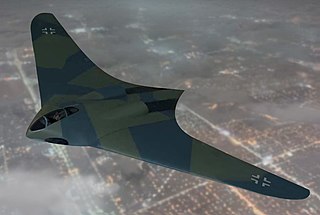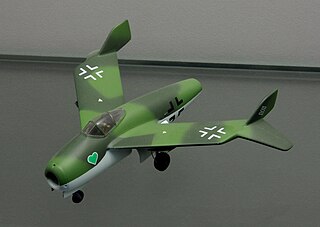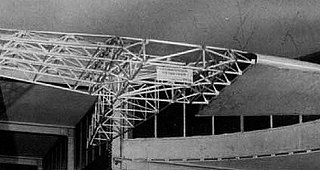
The Junkers J 5 was a designation assigned to several fighter aircraft designs.

The Junkers J 5 was a designation assigned to several fighter aircraft designs.
In early 1917, Junkers developed at least two cantilever wing monoplane fighter aircraft designs based on the J4. [1]
The first design, known as the J 5I, was to have a Siemens Sh2 or Oberursel UR.II engine behind the cockpit.
The second design was to have the engine in front of the pilot.
A third design was also developed under the designation J 5III (later J 6) with a Mercedes D.IIIa and a parasol wing.

A monoplane is a fixed-wing aircraft configuration with a single mainplane, in contrast to a biplane or other types of multiplanes, which have multiple planes.

A light bomber is a relatively small and fast type of military bomber aircraft that was primarily employed before the 1950s. Such aircraft would typically not carry more than one ton of ordnance.

The Horten H.IX, RLM designation Ho 229 was a German prototype fighter/bomber initially designed by Reimar and Walter Horten to be built by Gothaer Waggonfabrik. Developed at a late stage of the Second World War, it was the first flying wing to be powered by jet engines.

An attack aircraft, strike aircraft, or attack bomber is a tactical military aircraft that has a primary role of carrying out airstrikes with greater precision than bombers, and is prepared to encounter strong low-level air defenses while pressing the attack. This class of aircraft is designed mostly for close air support and naval air-to-surface missions, overlapping the tactical bomber mission. Designs dedicated to non-naval roles are often known as ground-attack aircraft.

Junkers Flugzeug- und Motorenwerke AG more commonly Junkers[ˈjʊŋkɐs], was a major German aircraft and aircraft engine manufacturer. It was founded in Dessau, Germany, in 1895 by Hugo Junkers, initially manufacturing boilers and radiators. During World War I and following the war, the company became famous for its pioneering all-metal aircraft. During World War II the company produced the German army's Luftwaffe planes, as well as piston and jet aircraft engines, albeit in the absence of its founder, who had been removed by the Nazis in 1934.

Hugo Junkers was a German aircraft engineer and aircraft designer who pioneered the design of all-metal airplanes and flying wings. His company, Junkers Flugzeug- und Motorenwerke AG, was one of the mainstays of the German aircraft industry in the years between World War I and World War II. His multi-engined, all-metal passenger- and freight planes helped establish airlines in Germany and around the world.

The mechanical structure of an aircraft is known as the airframe. This structure is typically considered to include the fuselage, undercarriage, empennage and wings, and excludes the propulsion system.

Nieuport, later Nieuport-Delage, was a French aeroplane company that primarily built racing aircraft before World War I and fighter aircraft during World War I and between the wars.

The Me 209 of 1943 was an attempt to create an enhanced version of the Bf 109, which served as the Luftwaffe's primary fighter aircraft throughout World War II. The Me 209, despite its designation, bore no relationship to the earlier Me 209.

The Fokker V.1 was a small German sesquiplane experimental fighter prototype built in 1916 by the Fokker-Flugzeugwerke. Sporting a parasol wing, it was the first Fokker aircraft purportedly designed by Reinhold Platz—the respective roles played by Fokker himself, Platz, and possibly others in the conceptual design of Fokker airplanes are a matter of dispute among historians—and was an early experiment in cantilever wing construction, eliminating the bracing wires typical of aircraft design at the time, something that had already been achieved with metal materials in Hugo Junkers' own pioneering Junkers J 1 in 1915.

The Junkers J.I was a German "J-class" armored sesquiplane of World War I, developed for low-level ground attack, observation and army cooperation. It is especially noteworthy as being the first all-metal aircraft to enter mass production; the aircraft's metal construction and heavy armour was an effective shield against small arms fire over the battlefield.

The Junkers J 1, nicknamed the Blechesel, was an experimental monoplane aircraft developed by Junkers & Co. It was the world's first all-metal aircraft.

The Junkers CL.I was a ground-attack aircraft developed in Germany during World War I. Its construction was undertaken by Junkers under the designation J 8 as proof of Hugo Junkers' belief in the monoplane, after his firm had been required by the Idflieg to submit a biplane as its entry in a competition to select a ground-attack aircraft. The J 8 design took the J 7 fighter as its starting point, but had a longer fuselage to accommodate a tail gunner, and larger wings. The prototype flew in late 1917 and was followed over the next few months by three more development aircraft. The Idflieg was sufficiently impressed to want to order the type, but had misgivings about Junkers' ability to manufacture the aircraft in quantity and considered asking Linke-Hoffmann to produce the type under licence. Finally, however, Junkers was allowed to undertake the manufacture as part of a joint venture with Fokker, producing a slightly modified version of the J 8 design as the J 10. Like the other Junkers designs of the period, the aircraft featured a metal framework that was skinned with corrugated duralumin sheets. 47 examples were delivered before the Armistice, including three built as floatplanes under the designation CLS.I. After the war, one or two CL.Is were converted for commercial service by enclosing the rear cockpit under a canopy.

The Junkers D.I was a monoplane fighter aircraft produced in Germany late in World War I, significant for becoming the first all-metal fighter to enter service. The prototype, a private venture by Junkers named the J 7, first flew on 17 September 1917, going through nearly a half-dozen detail changes in its design during its tests. When it was demonstrated to the Idflieg early the following year it proved impressive enough to result in an order for three additional aircraft for trials. The changes made by Junkers were significant enough for the firm to rename the next example the J 9, which was supplied to the Idflieg instead of the three J 7s ordered.

The Junkers J 2 was the first all-metal aircraft intended as a dedicated military aircraft design, the first all-metal aircraft meant to be a fighter aircraft, and was the direct descendant of the pioneering J 1 all-metal aircraft technology demonstrator design of 1915.

The Blohm & Voss P 212 was a proposed jet fighter designed by Blohm & Voss for the Emergency Fighter Program Luftwaffe design competition during the Second World War.

The Zeppelin D.I, or Zeppelin-Lindau D.I or Zeppelin D.I (Do), as named in German documents, also sometimes referred to postwar as the Dornier D.I or Dornier-Zeppelin D.I, for the designer, was a single-seat all-metal stressed skin monocoque cantilever-wing biplane fighter, developed by Claude Dornier while working for Luftschiffbau Zeppelin at their Lindau facility. It was too late to see operational service with the German Air Force (Luftstreitkräfte) during World War I.

The Friedrichshafen D.I was a German single-seat fighter plane developed by the Flugzeugbau Friedrichshafen during the First World War. Two prototypes were flown in 1917, but it was judged inferior to the Albatros D.III then in production and no further production ensued.

The Junkers J 3 was an all-metal single-seat experimental fighter aircraft.